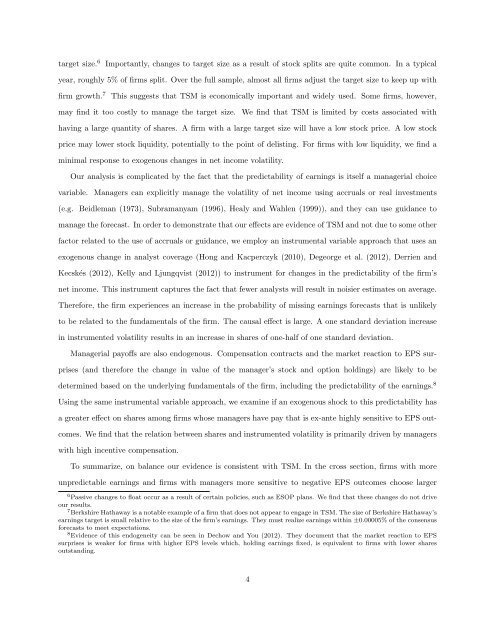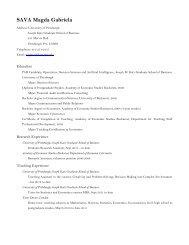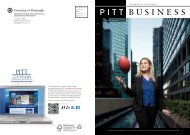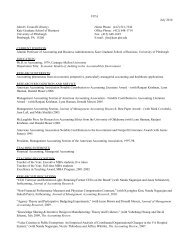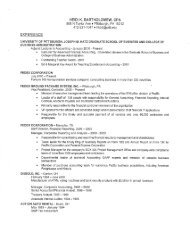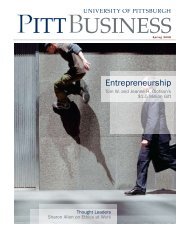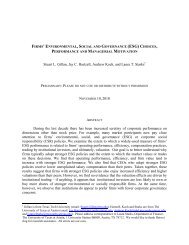Gaming the Float: How Managers Respond to EPS-based Incentives
Gaming the Float: How Managers Respond to EPS-based Incentives
Gaming the Float: How Managers Respond to EPS-based Incentives
Create successful ePaper yourself
Turn your PDF publications into a flip-book with our unique Google optimized e-Paper software.
target size. 6<br />
Importantly, changes <strong>to</strong> target size as a result of s<strong>to</strong>ck splits are quite common. In a typical<br />
year, roughly 5% of firms split. Over <strong>the</strong> full sample, almost all firms adjust <strong>the</strong> target size <strong>to</strong> keep up with<br />
firm growth. 7<br />
This suggests that TSM is economically important and widely used. Some firms, however,<br />
may find it <strong>to</strong>o costly <strong>to</strong> manage <strong>the</strong> target size. We find that TSM is limited by costs associated with<br />
having a large quantity of shares. A firm with a large target size will have a low s<strong>to</strong>ck price. A low s<strong>to</strong>ck<br />
price may lower s<strong>to</strong>ck liquidity, potentially <strong>to</strong> <strong>the</strong> point of delisting. For firms with low liquidity, we find a<br />
minimal response <strong>to</strong> exogenous changes in net income volatility.<br />
Our analysis is complicated by <strong>the</strong> fact that <strong>the</strong> predictability of earnings is itself a managerial choice<br />
variable. <strong>Managers</strong> can explicitly manage <strong>the</strong> volatility of net income using accruals or real investments<br />
(e.g. Beidleman (1973), Subramanyam (1996), Healy and Wahlen (1999)), and <strong>the</strong>y can use guidance <strong>to</strong><br />
manage <strong>the</strong> forecast. In order <strong>to</strong> demonstrate that our effects are evidence of TSM and not due <strong>to</strong> some o<strong>the</strong>r<br />
fac<strong>to</strong>r related <strong>to</strong> <strong>the</strong> use of accruals or guidance, we employ an instrumental variable approach that uses an<br />
exogenous change in analyst coverage (Hong and Kacperczyk (2010), Degeorge et al. (2012), Derrien and<br />
Kecskés (2012), Kelly and Ljungqvist (2012)) <strong>to</strong> instrument for changes in <strong>the</strong> predictability of <strong>the</strong> firm’s<br />
net income. This instrument captures <strong>the</strong> fact that fewer analysts will result in noisier estimates on average.<br />
Therefore, <strong>the</strong> firm experiences an increase in <strong>the</strong> probability of missing earnings forecasts that is unlikely<br />
<strong>to</strong> be related <strong>to</strong> <strong>the</strong> fundamentals of <strong>the</strong> firm. The causal effect is large. A one standard deviation increase<br />
in instrumented volatility results in an increase in shares of one-half of one standard deviation.<br />
Managerial payoffs are also endogenous. Compensation contracts and <strong>the</strong> market reaction <strong>to</strong> <strong>EPS</strong> surprises<br />
(and <strong>the</strong>refore <strong>the</strong> change in value of <strong>the</strong> manager’s s<strong>to</strong>ck and option holdings) are likely <strong>to</strong> be<br />
determined <strong>based</strong> on <strong>the</strong> underlying fundamentals of <strong>the</strong> firm, including <strong>the</strong> predictability of <strong>the</strong> earnings. 8<br />
Using <strong>the</strong> same instrumental variable approach, we examine if an exogenous shock <strong>to</strong> this predictability has<br />
a greater effect on shares among firms whose managers have pay that is ex-ante highly sensitive <strong>to</strong> <strong>EPS</strong> outcomes.<br />
We find that <strong>the</strong> relation between shares and instrumented volatility is primarily driven by managers<br />
with high incentive compensation.<br />
To summarize, on balance our evidence is consistent with TSM. In <strong>the</strong> cross section, firms with more<br />
unpredictable earnings and firms with managers more sensitive <strong>to</strong> negative <strong>EPS</strong> outcomes choose larger<br />
6 Passive changes <strong>to</strong> float occur as a result of certain policies, such as ESOP plans. We find that <strong>the</strong>se changes do not drive<br />
our results.<br />
7 Berkshire Hathaway is a notable example of a firm that does not appear <strong>to</strong> engage in TSM. The size of Berkshire Hathaway’s<br />
earnings target is small relative <strong>to</strong> <strong>the</strong> size of <strong>the</strong> firm’s earnings. They must realize earnings within ±0.00005% of <strong>the</strong> consensus<br />
forecasts <strong>to</strong> meet expectations.<br />
8 Evidence of this endogeneity can be seen in Dechow and You (2012). They document that <strong>the</strong> market reaction <strong>to</strong> <strong>EPS</strong><br />
surprises is weaker for firms with higher <strong>EPS</strong> levels which, holding earnings fixed, is equivalent <strong>to</strong> firms with lower shares<br />
outstanding.<br />
4


